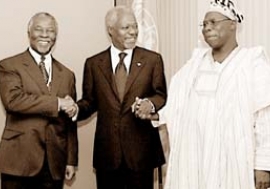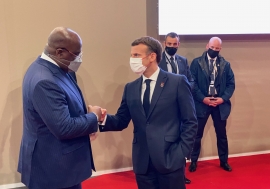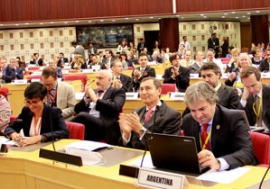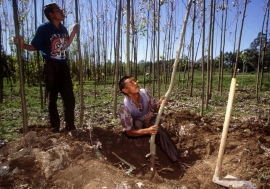For development finance, there is no one-size-fits-all solution
For development finance, there is no one-size-fits-all solution
Africa Renewal: The objectives entailed in the Financing for Development (FfD) draft document are many and ambitious. But they are non-binding and all address needs generally known to be important. What then is the value added of an Addis agreement?
Wu: The UN member States decided to have this conference before the September summit in New York where they are going to adopt a post-2015 development agenda with Sustainable Development Goals (SDGs) at its core. The purpose of the Addis conference is to develop the financial infrastructure needed to implement the new agenda. There are three major expectations for the Addis conference. First, the final financing framework has to be holistic, comprehensive and ambitious. We are not proposing solutions for one country or one group of countries, but for all 193 UN member countries. That means there’s no one-size-fits-all solution. Second, we need concrete deliverables and political commitments from all member States to provide the finances needed for sustainable development projects. And third, we need strong follow-up action.
In your estimation, are multilateral financial institutions, including the Bretton Woods, ready and able to fulfil a key role in FfD implementation?
The multilateral process identified five major institutional stakeholders – the World Bank Group, the International Monetary Fund and the World Trade Organization, the UN Development Programme and the UN Conference on Trade and Development. One of my priorities, and that of the UN Secretary-General, is to mobilize these institutions. You may be aware there was a Spring (March-April) meeting organized by the World Bank and the IMF, in which, for the first time in the history of the UN, Secretary-General Ban Ki-moon participated and got their political commitment to support the FfD conference. I am glad to say that all the five major institutions are on board. Their principals will bring to Addis new initiatives and concrete deliverables. The other support is from players who have become very active at the regional and global levels such as the BRICS [Brazil, Russia, India, China and South Africa], the Asian Infrastructure Bank, the Silk Road Infrastructure Fund and the Asian Development Bank. We will try to bring all of them on board for a common vision and a commitment to take whatever action is needed to support the Addis conference.
The outcome of the first conference on financing for development, the Monterrey Consensus, addressed the role of the private sector in FfD, but largely for objective purposes. The currently-circulating draft FfD text differs in that it assigns and asks for a willing, subjective purpose, especially in areas such as corporate sustainability, sustainable finance, impact investing, etc. Would you agree with this assessment?
I would go along with your assessment. The importance of private sector financing was recognized a long time ago. We need to mobilize private finance for sustainable development. The UN wants to define the roles of the private sector and private resources because we are confronted with unprecedented challenges. In the past, we used to talk about development of a group of countries or of economic growth alone. We are now stepping beyond that. We are talking about economic growth, social development and environmental protection—the three different aspects of one issue—sustainability. So you can imagine the amount of resources needed to support this programme. We need all types of financial resources—domestic, international, public and private.
Private financial resources are very important, but the challenge is how to mobilize them. We believe public policies will play a central role in creating an enabling environment at the domestic, regional and international levels. And of course, both the quantity and quality of private investment, particularly in infrastructure, is important. I hope the Addis accord will provide a new financing framework that will bring the private sector on board so it can make meaningful contributions to sustainable development.
Another area that has emerged since the Monterrey conference on FfD is the expanded role of South-South cooperation. How do you see that taking shape in the Addis discussions and after?
South-South cooperation is becoming increasingly more important. Triangular and South-South cooperation are important new features in the changing global financial system since the Monterrey Consensus. We are very supportive of this development. We believe that in many ways it serves as a good example for all countries. The programmes developed are considered cost-effective. They involve technology transfer, and the cost of personnel overhead is low, hence not much is spent on the cost of experts, their travel and accommodations compared to what is actually spent in host countries.
However, it is important to stress that this kind of mutual assistance will not serve as a substitute for North-South cooperation. Official development assistance is still essential. The two formats can supplement each other. But we often think of South-South as poor countries helping the poor, so it is different in nature than North-South. We would like to see South-South cooperation playing a more important role in the world, just as we urge donor nations to do more – at least to fulfil their own commitments.
The renowned Marshall Plan provided Europe with reconstruction monies in the amount of 0.2% of GDP of the US. The world finance-to-GDP ratio of the SDGs is variously estimated at 2, 3 or 4% and includes economies much less prosperous than the US in the 1950s. Is the new requirement likely to burden low-income regions such as Africa?
We are not in the 1950s, and so a Marshall Plan would not be good for the future of sustainable development. We are trying to mobilize all resources possible – international, domestic, private and public. In addition, we need to encourage technology transfer, tax reforms, efforts to stop illegal financial outflows, reductions in the cost of transferring remittances and strengthen capacity building. If we mobilize these initiatives successfully, we will be able to meet our needs. How much money would be needed? It’s very difficult to predict or quantify because that depends on many uncertainties.
True, many developing countries lack resources. But it’s important to note that there is ownership of financing for sustainable development at the national level. Historically, all economic development has been driven by a country’s own resources mobilized by national governments. That’s why the Member States emphasized the ownership of local resources. In many cases, however, these are not enough. Countries need strong and effective international partnerships. On their part, the national governments need to create an enabling environment; otherwise the money will not be forthcoming. This is precisely why official development assistance will be vital. Further, not all countries will implement all the 169 targets; that is impossible, even for the most developed countries. Countries will choose targets that are best suited to their local conditions. The Addis conference will offer more policy recommendations from which to choose and consider.
The SDGs text says that targets are “aspirational”, with each government setting its own national targets guided by the global level of ambition but taking into account national circumstances.” Does this qualification provide a safeguard that allows poor countries to implement SDGs without straining their budgets?
The sustainable development agenda not only covers a wider area, but also applies to all countries. Plans are often designed or targeted largely for certain countries or groups of countries. The challenge this time is for all countries to sit down together and produce a comprehensive plan that will accommodate all individual situations. Despite the principle of universality, the reality is one cannot apply uniformly all SDGs to all countries. The U.S. or Switzerland, for example, would not implement the same goals as the least developed countries because the developed countries have already achieved some of the goals. I should emphasize that first we need to change the mind-set of public administrators. Second, we have to tear down all the political and economic silos at ministerial levels. When we start implementing the sustainable development agenda, it will be important for ministers to change their traditional ways of doing business. I urge them and their governments to think in revolutionary ways on how we can work together, how we can make sustainable development work.
























